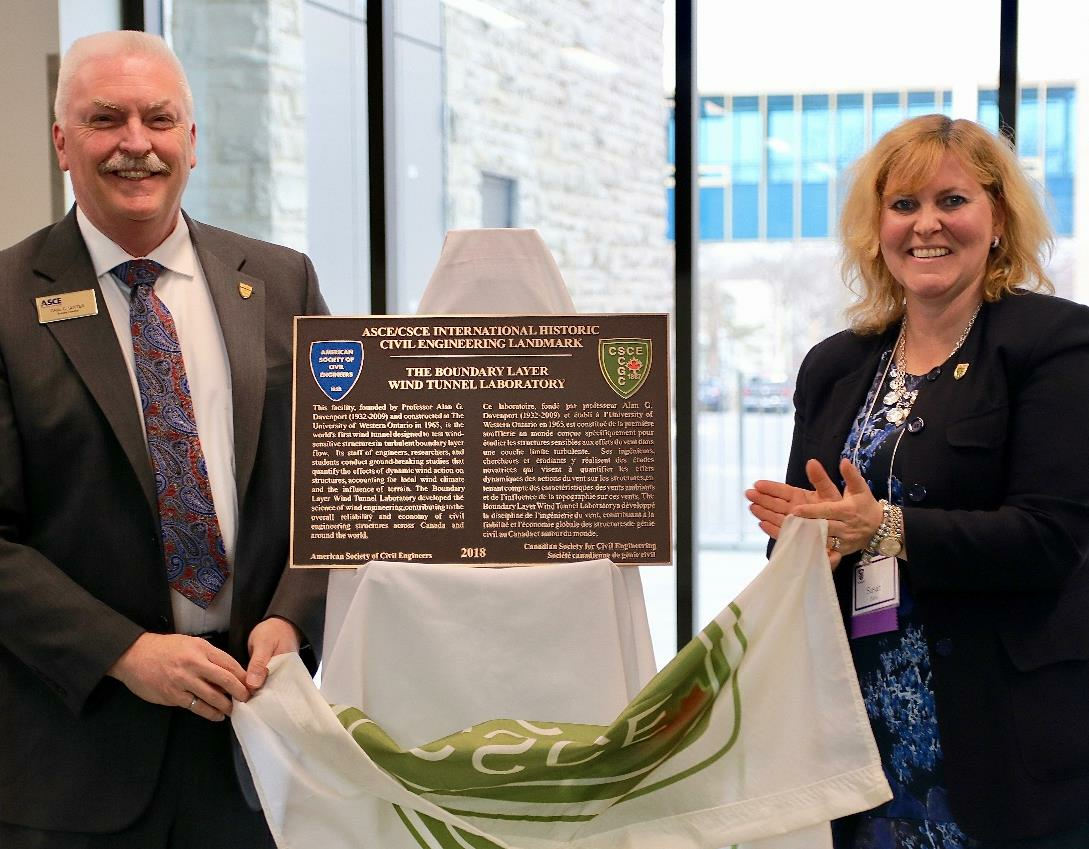
Boundary Layer Wind Tunnel I (1965)
Site Location: Long: 81⁰-16’-32” W; Lat: 43⁰-00’-15” N. On the grounds of Western University. Take Wharncliffe Road north past Oxford Street, where it is renamed Western Road. Continue north on Western Road past the traffic light at Sarnia Road to turn left (east) at the next traffic light, Lambton Drive. Drive one block down the hill to the traffic circle in front of Alumni Hall, and take the first exit (south) between the observatory and Alumni Hall to the Alumni/Thompson Parking Lot. Park. Walk south towards the Recreation Centre past the Thompson Engineering Building, then west to the Boundary Layer Wind Tunnel Laboratory.
Plaque Location: On the West exterior wall of the Boundary Layer Wind Tunnel Laboratory, beside the main entrance.

Plaque Mounted on West Exterior Wall of Wind Tunnel, Beside Entrance

Plaque Detail.
Description: Boundary Layer Wind Tunnel I, completed in 1965, was conceived and founded by civil engineer Professor Alan G. Davenport, and designed by Davenport and Jim W. Stewart, a fellow engineer and professor at Western. It is 100 feet (30 m) long, 8 feet (2.4 m) wide and has an adjustable roof to achieve a height between 5.5 and 7.5 feet (1.7 and 2.3 m). In 1984 it was supplemented by BLWT II, a closed-circuit wind tunnel that includes adjustable roughness elements that can be pre-programmed to create particular turbulent wind profile characteristics.
Historic Significance: The Boundary Layer Wind Tunnel Laboratory contains the world’s first wind tunnel designed to test wind-sensitive structures in turbulent boundary layer flow. Its staff of engineers, researchers, and students quantify the effects of dynamic wind action on structures, accounting for local wind climate and the influence of terrain. The Laboratory developed the science of wind engineering. Since 1965, its staff have produced over 2,000 reports from wind studies conducted on remarkable buildings such as the Willis Tower (Chicago), CN Tower (Toronto), Bank of China Tower (Hong Kong), and Canary Wharf Complex (London), and bridges including the Sunshine Skyway Bridge (Tampa), Bronx-Whitestone Bridge (New York), Tsing Ma Bridge ( Hong Kong), and Confederation Bridge (New Brunswick/ Prince Edward Island).
Plaque Unveiling Ceremony: The plaque was unveiled during a public ceremony at Western’s Amit Chakma Engineering Building on April 4, 2019.

Commemorative Plaque with (l to r): Dr. Greg Kopp, Acting Dean of the Faculty of Engineering; Dr. Peter King, past Director of the BLWTL; Mr. Carl Sutter; Mr. Peter Case, current Director of the BLWTL; Dr. Susan Tighe, Dr. Mike Bartlett, Chair of the CSCE National History Committee, and Ms. Sangie Zaitsoff, a doctoral candidate at Western’s Centre for Theory and Criticism. Ms. Zaitsoff and Dr. King were lead authors of the nomination documents. (photo credit: Paul Mayne, Western University)

Carl C. Sutter, Regional Director of the ASCE, and Dr. Susan L. Tighe, Past President of the CSCE, unveil the plaque. (photo credit: Paul Mayne, Western University)
Plaque Text: ASCE/CSCE International Historic Civil Engineering Landmark. THE BOUNDARY LAYER WIND TUNNEL LABORATORY. This facility, founded by Professor Alan G. Davenport (1932-2009) and constructed at The University of Western Ontario in 1965, is the world’s first wind tunnel designed to test wind-sensitive structures in turbulent boundary layer flow. Its staff of engineers, researchers, and students conduct ground-breaking studies that quantify the effects of dynamic wind action on structures, accounting for local wind climate and the influence of terrain. The Boundary Layer Wind Tunnel Laboratory developed the science of wind engineering, contributing to the overall reliability and economy of civil engineering structures across Canada and around the world. American Society of Civil Engineers. 2018. Canadian Society for Civil Engineering.
THE BOUNDARY LAYER WIND TUNNEL LABORATORY. Ce laboratoire, fondé par professeur Alan G. Davenport (1932-2009) et établi à l’University of Western Ontario en 1965, est constitué de la première soufflerie au mond conçue spécifiquement pour étudier les structures sensibles aux effets du vent dans un couche limite turbulente. Ses ingénieurs, chercheurs et étudiants y réalisent des études novatrices qui visent à quantifier les effets dynamique des actions du vent sure les structures, en tenant compte des charactéristiques des vents ambiants e de l’influence de la topographie sur ces vents. The Boundary Layer Wind Tunnel Laboratory a développé la discipline de l’ingénierie du vent, contribuant à la fiabilité et l’économie globale des structures de géne civil au Canada et autour du monde. American Society of Civil Engineers 2018 Société canadienne de génie civil.
Link to Further Documentation: